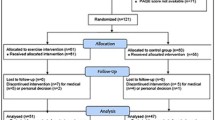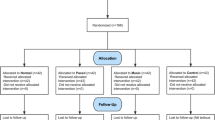Abstract
This study examined the influence of a 1-year brisk walking programme on endurance fitness and the amount and distribution of body fat in a group of formerly sedentary men. Seventy-two males, aged 42–59 years, body mass index 25.2 (0.3) kg·m−2 [mean (SEM)], were randomly allocated to either a walking group (n = 48) or control group (n = 24). Brisk walking speed was evaluated using a 1.6-km track walk. Changes in endurance fitness were assessed by measuring blood lactate concentration and heart rate during submaximal treadmill walking. Body composition was determined by hydrostatic weighing and anthropometry; energy intake was assessed from 7-day weighed food inventories. Differences in the response of walkers and controls were examined using two-way analyses of variance. Forty-two walkers (87.5%) completed the study and averaged 27.9 (1.4) min·day−1 of brisk walking (range 11–46). Brisk walking speed averaged 1.95 (0.03) m·s−1 and elicited approximately 68 (1) % of maximum heart rate. Heart rate and blood lactate concentration during submaximal treadmill walking were significantly reduced in the walkers after 3, 6 and 12 months and the oxygen uptake at a reference blood lactate concentration of 2 mmol·l−1 was increased by 3.2 ml·kg−1. min−1 (14.9%) in the walkers at 6 months (P< 0.01). Although skinfold thicknesses at anterior thigh and medial calf sites decreased significantly for the walkers, the response of the two groups did not differ significantly for other body composition variables or for energy intake.
Similar content being viewed by others
References
Ainsworth BA, Haskell WL, Leon AS, Jacobs DR, Montoye HJ, Sallis JF, Paffenbarger RS (1993) Compendium of physical activities: classification of energy costs of human physical activities. Med Sci Sports Exerc 25:71–80
American College of Sports Medicine (1991) Guidelines for exercise testing and prescription, 4th edn. Lea and Febiger, Philadelphia
Astrand PO (1992) Why exercise? Med Sci Sports Exerc 24:153–162
Astrand PO, Rodahl K (1986) Textbook of work physiology: physiological bases of exercise, 3rd edn. McGraw-Hill, New York
Ballor DL, Keesey RE (1991) A meta-analysis of the factors affecting exercise-induced changes in body mass, fat mass and fat-free mass in males and females. Int J Obesity 15:717–726
Bergman EA, Boyungs JC (1991) Indoor walking programme increases lean body composition in older women. J Am Diet Assoc 91:1433–1435
Berlin JA, Colditz GA (1990) A meta-analysis of physical activity in the prevention of coronary heart disease. Am J Epidemiol 132:612–628
Brooks GA (1991) Current concepts in lactate exchange. Med Sci Sports Exerc 23:895–906
Davies KJA, Packer L, Brooks GA (1981) Biochemical adaptation of mitochondria, muscle and whole-animal respiration to endurance training. Arch Biochem Biophys 209:539–554
Despres JP, Bouchard C, Tremblay A, Savard R, Marcotte M (1985) Effects of aerobic training on fat distribution in male subjects. Med Sci Sports Exerc 17:113–118
Durnin JVGA, Rahaman MM (1967) The assessment of the amount of fat in the human body from measurements of skinfold thickness. Br J Nutr 21:681–689
Durnin JVGA, Womersley J (1974) Body fat assessed from total body density and its estimation from skinfold thicknesses: measurements on 481 men and women aged from 16 to 72 years. Br J Nutr 32:77–97
Hardman AE, Jones PRM, Norgan NG, Hudson A (1992) Brisk walking improves endurance fitness without changing body fatness in previously sedentary women. Eur J Appl Physiol 65:354–359
Himes JH (1988) Alteration in distribution of adipose tissue in response to nutritional intervention. In: Bouchard C, Johnston FE (eds) Fat distribution during growth and later health outcomes. Liss, New York, pp 313–332
Holloszy JO (1988) Metabolic consequences of endurance exercise training. In: Horton ES, Terjung RL (eds) Exercise, nutrition, and energy metabolism. Macmillan, New York, pp 116–131
Jette M, Sidney K, Campbell J (1988) Effects of a twelve-week walking programme on maximal and submaximal work output indices in sedentary middle-aged men and women. J Sports Med Phys Fitness 28:59–66
Macrae HSH, Dennis SC, Bosch AN, Noakes TD (1992) Effects of training on lactate production and removal during progressive exercise in humans. J Appl Physiol 72:1649–1656
Maritz JS, Morrison JF, Peter J, Strydom NB, Wyndham CH (1961) A practical method of estimating an individual's maximal oxygen intake. Ergonomics 4:97–122
Marr JW (1971) Individual dietary surveys: purposes and methods. World Rev Nutr Diet 13:105–164
Martin JE, Dubbert PM (1982) Exercise applications and promotion in behavioural medicine: current status and future directions. J Consult Clin Psychol 50:1004–1017
Matoba H, Gollnick PD (1984) Response of skeletal muscle to training. Sports Med 1:240–251
Maughan RJ (1982) A simple, rapid method for the determination of glucose, lactate, pyruvate, alanine, 3-hydroxybutyrate and acetoacetate on a single 20 μl blood sample. Clin Chim Acta 122:231–240
Morris JN, Clayton DG, Everitt MG, Semmence AM, Burgess EH (1990) Exercise in leisure time: coronary attack and death rates. Br Heart J 63:325–334
Norgan NG (1991) Body composition methodology: densitometry. In: Fidanza F (ed) Nutritional status assessment. Chapman and Hall, London, pp 64–70
Office of Population Censuses and Surveys (1980) Classification of occupations. HMSO, London
Office of Population Censuses and Surveys (1984) The height and weight of adults in Great Britain. HMSO, London
Office of Population Censuses and Surveys (1990) The dietary and nutritional survey of British adults. HMSO, London
Office of Population Censuses and Surveys (1991) Deaths by cause: 1990 registrations. Monitor DH2 91/2. HMSO, London
Paul AA, Southgate DAT (1988) McCance and Widdowson's, “The composition of foods”, 4th ed. HMSO, London
Pollock ML, Miller HS, Janeway R, Linnerud AC, Robertson B, Valentino R (1971) Effects of walking on body composition and cardiovascular function of middle-aged men. J Appl Physiol 30:126–130
Pollock ML, Carroll JF, Graves JE, Leggett SH, Braith RW, Limacher M, Hagberg JM (1991) Injuries and adherence to walk/jog and resistance training programmes in the elderly. Med Sci Sports Exerc 23:1194–1200
Porcari J, McCarron R, Kline G, Freedson PS, Ward A, Ross JA, Rippe JM (1987) Is fast walking an adequate aerobic training stimulus for 30–69 year old men and women? Phys Sportsmed 15:119–129
Porcari JP, Ebbeling CB, Ward A, Freedson PS, Rippe JM (1989) Walking for exercise testing and training. Sports Med 8:189–200
Powell KE, Thompson PD, Caspersen CJ, Kendrick JS (1987) Physical activity and the incidence of coronary heart disease. Annu Rev Publ Health 8:253–287
Rahn H, Fenn WO, Otis AB (1949) Daily variations of vital capacity, residual air and expiratory reserve including a study of the residual air method. J Appl Physiol 1:725–736
Santiago MC, Alexander JF, Stull GA, Serfass RC, Hayday AM, Leon AS (1987) Physiological responses of sedentary women to a 20-week conditioning programme of walking and jogging. Scand J Sports Sci 9:33–39
Schwartz RS, Shuman WP, Larson V, Cain KC, Fellingham GW, Beard JC, Kahn SE, Stratton JR, Cerqueira MD, Abrass IB (1991) The effect of intensive endurance exercise training on body fat distribution in young and older men. Metabolism 40:545–551
Seals DR, Hagberg JM, Hurley BF, Ehsani AA, Holloszy JO (1984a) Endurance training in older men and women. I. Cardiovascular responses to exercise. J Appl Physiol Respir Environ Exerc Physiol 57:1024–1029
Seals DR, Hurley BF, Schultz J, Hagberg JM (1984b) Endurance training in older men and women. II. Blood lactate response to submaximal exercise. J Appl Physiol Respir Environ Exerc Physiol 57:1030–1033
Siri WE (1961) Body composition from fluid spaces and density. In: Brozek J, Henschel A (eds) Techniques for measuring body composition. National Academy of Sciences/National Research Council, Washington, D.C., pp 223–244
Sports Council and Health Education Authority (1992) The National Fitness Survey: a report on activity patterns and fitness levels
Tremblay A, Despres JP, Bouchard C (1988) Alteration in body fat and body fat distribution with exercise. In: Bouchard C, Johnston FE (eds) Fat distribution during growth and later health outcomes. Liss, New York, pp 297–312
Weiner JS, Lourie JA (1981) Practical human biology. Academic Press, London
Williams C, Nute MLG (1982) The influence of short-term training on the maximum oxygen uptake and endurance capacity of male and female subjects. Br J Sports Med 16:107
Author information
Authors and Affiliations
Rights and permissions
About this article
Cite this article
Stensel, D.J., Brooke-Wavell, K., Hardman, A.E. et al. The influence of a 1-year programme of brisk walking on endurance fitness and body composition in previously sedentary men aged 42–59 years. Europ. J. Appl. Physiol. 68, 531–537 (1994). https://doi.org/10.1007/BF00599525
Accepted:
Issue Date:
DOI: https://doi.org/10.1007/BF00599525




